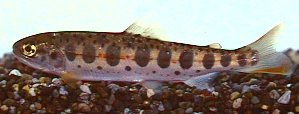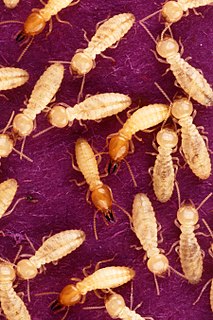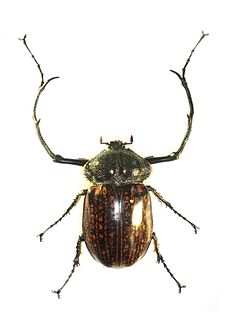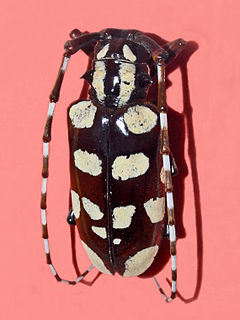
Oncorhynchus masou, known as the masu salmon, masu, or the cherry hybrid salmon, is a species of salmon found in the northern part of the Pacific Ocean along East Asia, ranging from the Kamchatka, Kuril Islands, Sakhalin, and Primorsky Krai south through Korea, Taiwan, and Japan. A number of subspecies are known, including the anadromous, widespread masu Oncorhynchus masou masou, the critically endangered, landlocked Taiwanese or Formosan salmon Oncorhynchus masou formosanus found in certain freshwater systems of Taiwan, the Biwa trout endemic of Lake Biwa, and the anadromous or stream-dwelling amago Oncorhynchus masou macrostomus restricted to western Japan.

The Formosan termite is an invasive species of termite. It has been transported worldwide from its native range in southern China to Formosa and Japan. In the 20th century, it became established in South Africa, Sri Lanka, Hawaii, and the continental United States.
Sinopanax formosanus is a species of flowering plant in the family Araliaceae and the only species in the genus Sinopanax. It is endemic to Taiwan. It is a small, evergreen tree, up to 12 metres (39 ft) in height, that grows in open areas in mountainous forests at altitudes between 2,300–2,600 metres (7,500–8,500 ft).
Hemimyzon taitungensis is a species of ray-finned fish in the family Balitoridae that is endemic to Taiwan. It is a small freshwater fish currently known only from running waters of the Central Mountain Range of Taiwan at high and middle elevations. In contrast to H. formosanus, it appears to be a well-defined species with no signs of strong genetic structuring suggestive of cryptic species.
The Taiwan salamander, Hynobius formosanus, is a species of salamander in the family Hynobiidae, endemic to Taiwan, where it occurs in the high mountains at around 2,100 m (6,900 ft). Its natural habitats are from open alpine habitats to shaded moist evergreen forests. Adults have a total length of 58–98 mm (2.3–3.9 in).

Oncorhynchus masou formosanus, the Formosan landlocked salmon or Taiwanese salmon, is a freshwater salmonid fish endemic to Taiwan.
Lithocarpus dodonaeifolius is a species of tree in the family Fagaceae. L. dodonaeifolius is a medium-sized tree, up to 9 m (30 ft) tall. It is endemic to Taiwan and only occurs in the Hengchun Peninsula in the extreme south of the country. It grows in mixed mesophytic forests at altitudes of 500–1,500 m (1,600–4,900 ft).
Lithocarpus formosanus is a species of tree in the Fagaceae family. L. formosanus is a medium-sized tree with crooked trunk and many branches. It is endemic to Taiwan as it only occurs in the Hengchun Peninsula in the extreme south of the country. It grows in mixed mesophytic forests at altitudes of 100–500 m (330–1,640 ft). Only single population of fewer than 50 individuals survives.

Euchirinae is a subfamily of Scarabaeidae or scarab beetles in the superfamily Scarabaeoidea. They are sometimes referred to as "long-armed scarabs" due to the elongated forelegs of the males. These long legs often have median and apical spines that are fixed in the male while females have a movable terminal spine.
Hemimyzon formosanus is a species of hillstream loach in the genus Hemimyzon. It is endemic to western portion of Central Mountain Range of Taiwan. Its maximum length is 10 cm (3.9 in). Variations in nucleotide sequences within the mitochondrial control region show strong geographic structuring suggestive of a cryptic species complex.
Hemimyzon sheni is a species of ray-finned fish in the genus Hemimyzon. It is only known from Tar-Ju River basin, Taitung County, southeast Taiwan, where its type locality is. Only three specimens were collected and later attempts to find more specimens have failed. Among its relatives, H. sheni most closely resembles H. formosanus, but it seems to be more a head-water species than H. formosanus. It is a small species with standard length of 5 cm (2.0 in).

Anoplophora horsfieldi is a species of beetles in the longhorn beetle family (Cerambycidae).
Liobagrus formosanus is a species of catfish in the family Amblycipitidae. It is endemic to Taiwan. This species reaches a maximum length of 8.6 centimetres (3.4 in) standard length.

Thylactus is a genus of longhorn beetles of the subfamily Lamiinae, containing the following species:

Achalinus formosanus, common name Formosan odd-scaled snake or Taiwan burrowing snake, is a non-venomous snake in family Xenodermatidae that is found in Taiwan and in the southern Ryukyu Islands (Japan).
Olenecamptus formosanus is a species of beetle in the family Cerambycidae. It was described by Maurice Pic in 1914. It contains the varietas Olenecamptus formosanus var. decemmaculatus. It occurs in East Asia.

Takydromus formosanus, also known as the Formosa grass lizard, is a species of lizard endemic to Taiwan. Its body is about 6 cm long, and the total length reaches 22 cm. Its back is brown, with a yellow-green stripe on its side. It is mainly found in mountains at elevations of up to 1500 m, living in grasses and shrubs. It is diurnal and eats small invertebrates. It is capable of caudal autotomy. The species was described by George Albert Boulenger in 1894.
Oligodon formosanus is a species of snake of the family Colubridae.
Thylactus chinensis is a species of beetle in the family Cerambycidae. It was described by Kriesche in 1924. It is known from Vietnam, China and Taiwan.









